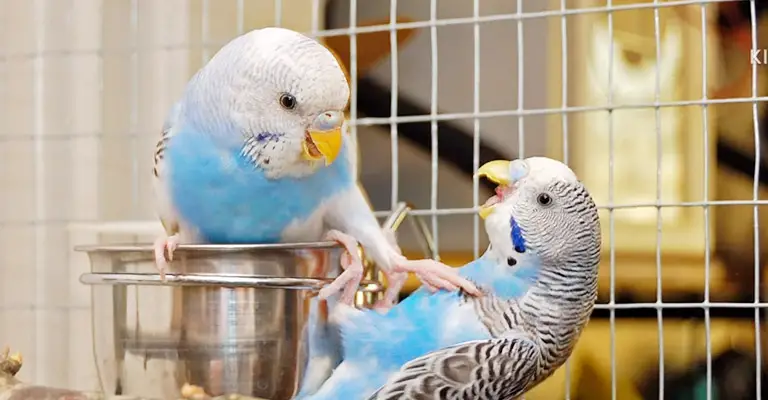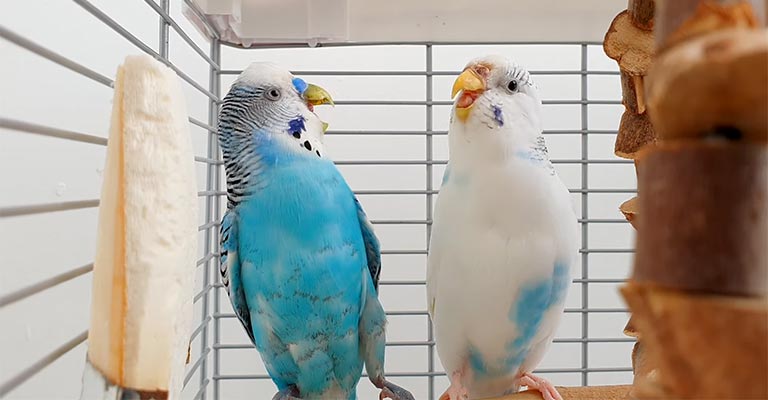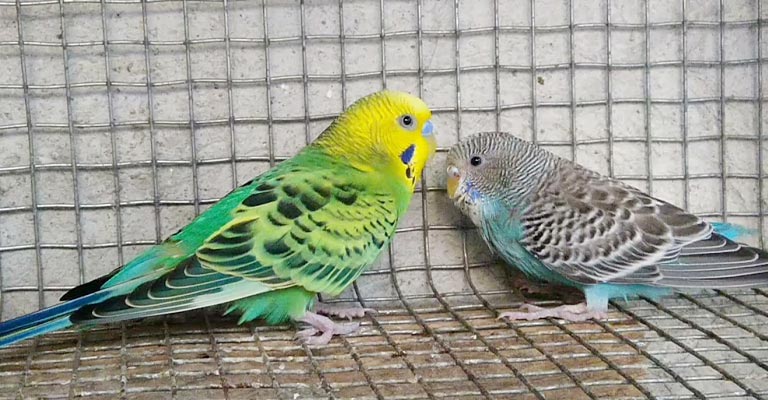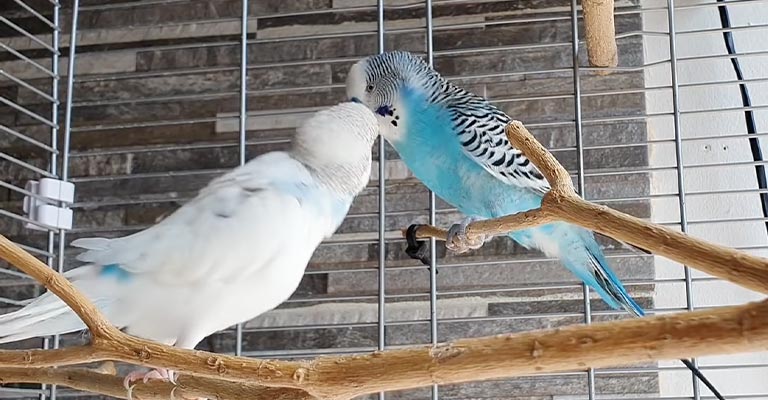The dynamic between male and female parakeets can be both fascinating and challenging for pet owners. Parakeets, known for their vibrant plumage and sociable nature, often form close bonds with their cage mates.
However, it’s not uncommon for parakeet owners to witness instances where a male parakeet appears to be attacking a female counterpart. This puzzling behavior can raise concerns and questions about the well-being and compatibility of the birds.
Understanding why is my male parakeet attacking my female for fostering a harmonious environment for your avian companions.
Various factors, such as territorial behavior, mating-related issues, jealousy, or even health problems, can contribute to male parakeets’ aggression toward females.
This article will delve into these underlying causes and provide insights into how to manage and address this issue, ensuring the overall well-being of your feathered friends.

Why Is My Male Parakeet Attacking My Female?
Here’s why is your male parakeet attacking your female:
Territorial Behavior
Male parakeets can become territorial, especially if they perceive their cage or a particular nesting spot as their territory. If the male feels threatened by the female’s presence in his perceived territory, he might display aggressive behavior to protect it.
Breeding Season
During the breeding season, male parakeets may become more aggressive, trying to establish their dominance and court the females. However, if the female is not receptive, she might resist the male’s advances, leading to aggressive behavior.
Jealousy and Competition
Parakeets can get jealous, especially if they see their favorite human interacting with the opposite sex. Jealousy can lead to aggressive behavior towards the perceived rival, in this case, the female parakeet.
Mating Rejection
If the female parakeet rejects the male’s attempts to mate, he might become frustrated and aggressive. Rejection can happen due to various factors, including health issues or the female not being in the mating mood.
Health Problems
Sometimes, aggression can be a sign of underlying health issues in either the male or the female parakeet. Pain or discomfort can make a parakeet irritable and more prone to aggressive behavior.
Insufficient Space
Limited space within the cage can lead to stress and aggression among parakeets. If the cage is too small, the birds might feel cramped, and territorial disputes, including aggression towards the female, can arise.
Social Hierarchy
Parakeets establish social hierarchies within their flock, and if the male perceives the female as a threat to his position in the hierarchy, he might become aggressive.
This behavior is more common when introducing a new female into an existing male-dominated group.
Understanding the specific circumstances and observing the parakeets’ behavior can help identify the underlying cause of aggression.
Providing a spacious cage, ensuring both birds are healthy, and monitoring their interactions can mitigate aggression and create a harmonious environment for your parakeets.
What To Do When My Male Parakeet Attacks My Female Parakeet?

Let’s discuss what to do when your male parakeet attacks your female parakeet:
Separation
If the male parakeet’s aggression is causing harm to the female or significantly stressing her out, consider temporarily separating them into separate cages. This will ensure the female’s safety and reduce tension between them.
Observation and Identification
Pay close attention to the triggers of aggression. Understand the specific situations or actions that lead to conflict between the parakeets. Identifying the root cause can help you address the issue more effectively.
Provide Adequate Space
Ensure that the cage is spacious enough to accommodate both parakeets comfortably. A larger cage with multiple perches, toys, and feeding stations can reduce territorial disputes.
Introduce New Toys and Distractions
Enrich their environment with new toys and activities to keep both parakeets mentally stimulated. This can divert their attention from each other and reduce tension.
Reconsider Cage Placement
Changing the location of the cage within your home can sometimes make a difference. Placing the cage in a quieter, less trafficked area can help reduce stress and aggression.
Consult an Avian Veterinarian
If the aggression persists, it’s crucial to consult with an avian veterinarian to rule out any underlying health issues that may be contributing to the behavior. Illness or pain can make a parakeet more irritable and prone to aggression.
Gradual Reintroduction
If you separate the parakeets, reintroduce them gradually and monitor their behavior. Start with short supervised interactions and gradually increase the time they spend together. This can help them readjust to each other’s presence without undue stress.
Remember that some degree of squabbling is normal among parakeets as they establish social hierarchies.
However, if the aggression continues or escalates to the point of harming one of the birds, it’s essential to take steps to ensure their safety and well-being.
Professional advice from an avian veterinarian or a bird behaviorist may be necessary in severe cases of aggression.
What Do I Do To Make My Male Parakeet Like My Female Parakeet?

Building a positive relationship between your male and female parakeets is essential for their well-being. Here are some tips to help them get along:
Provide a Spacious Cage
Ensure the cage is large enough to accommodate both birds comfortably. Parakeets appreciate space to move around and explore. A roomy cage reduces the likelihood of territorial disputes and encourages a more harmonious coexistence.
Pairing Compatibility
When selecting parakeets, consider their compatibility. Some birds may have personalities that naturally mesh well, reducing the likelihood of conflict. It’s helpful to choose birds that are of similar age and have been socialized from a young age.
Introduce Slowly
If you are introducing a new female to your male parakeet, do so gradually. Start by placing their cages side by side for a few days to allow them to get used to each other’s presence without direct contact.
Once they seem comfortable, you can allow them supervised interactions outside the cages.
Shared Activities
Encourage shared activities, such as playing with toys or sharing treats. Providing opportunities for them to engage in positive, non-threatening interactions can help build a bond.
Social Time
Spend time with both parakeets, giving them individual attention and socializing with them together. This can help the male parakeet associate the female’s presence with positive experiences.
Nesting Box and Nesting Material
If you intend for them to breed, provide a nesting box and nesting materials. The act of building a nest and caring for eggs and chicks can often strengthen the bond between male and female parakeets.
Patience and Monitoring
Building a positive relationship takes time, and not all parakeets will instantly get along. Be patient and monitor their interactions closely.
If any signs of aggression or stress occur, be prepared to separate them temporarily and try reintroducing them later.
Remember that not all parakeets will become best friends, but with patience and the right environment, many can learn to coexist peacefully.
It’s essential to prioritize their well-being and ensure they are both comfortable and stress-free in each other’s presence.
How Do Male And Female Parakeets Get Along After Fighting?

Rebuilding a positive relationship between male and female parakeets after a fight requires patience, understanding, and careful intervention. Here are some ways to help them get along after a conflict:
Separation and Cooling Off
After a fight, it’s crucial to separate the parakeets to prevent further aggression and give them a chance to cool off.
Place them in separate cages for a period, ensuring they cannot see or physically interact with each other. This separation provides a break from the tension and reduces stress.
Gradual Reintroduction
Once the parakeets have spent some time apart, reintroduce them gradually. Begin by placing their cages near each other without direct contact. Allow them to observe and get used to each other’s presence again.
If they seem calm, you can proceed to supervised face-to-face interactions.
Supervised Interactions
When you reintroduce them, supervise their interactions closely. Be prepared to intervene if any signs of aggression reappear. Keeping a close eye on their behavior ensures their safety and allows you to separate them if needed.
Positive Reinforcement
Encourage positive interactions by offering treats and praise when they are calm and non-aggressive around each other. Positive reinforcement can help them associate being together with positive experiences, reinforcing peaceful behavior.
Separate Feeding and Perching Spaces
In the shared living environment, separate feeding dishes and perches are provided for each parakeet. This reduces competition for resources and helps prevent future disputes over food or perching spots.
Environmental Enrichment
Enrich their environment with toys, swings, and activities that engage their attention. Boredom and lack of mental stimulation can lead to aggression, so providing an enriched environment can distract them from potential conflicts.
Patience and Time
Rebuilding trust and a positive relationship takes time. Be patient and allow the parakeets the necessary time to adjust to each other again. Avoid rushing the process, as forcing them together too soon can lead to renewed aggression.
It’s essential to approach the reintroduction process with caution and sensitivity to the parakeets’ behavior. Each bird has its own personality, and the time it takes for them to reconcile can vary.
By providing a safe and supportive environment, monitoring their interactions, and reinforcing positive behavior, you can help your male and female parakeets rebuild their relationship after a fight.
FAQs
Why is my male parakeet suddenly attacking my female parakeet?
Sudden aggression in male parakeets towards their female counterparts can be triggered by various factors. These include territorial disputes, jealousy, mating-related tension, and underlying health issues.
Can male parakeets become aggressive during breeding season?
Yes, it’s common for male parakeets to exhibit more aggression during the breeding season. They may become more territorial and assertive as they try to court the female. However, if the female rejects their advances or they face breeding-related stress, it can lead to conflict.
Is it possible for my male and female parakeets to coexist peacefully?
Yes, with the right approach, male and female parakeets can coexist harmoniously. Providing a spacious cage, supervised interactions, and positive reinforcement can help build a positive relationship. Patience and monitoring are key as they gradually adjust to each other’s presence.
Could my male parakeet’s aggression be due to health issues?
Yes, health problems can contribute to aggression in male parakeets. Pain, discomfort, or illness can make a bird irritable and more prone to aggressive behavior. If you suspect health issues, consult an avian veterinarian for a thorough examination.
What can I do to prevent my male parakeet from attacking my female in the first place?
To prevent aggression, ensure a spacious cage, select compatible birds, and introduce them gradually. Offer a stimulating environment, encourage shared activities, and provide positive reinforcement.
Conclusion
In the intricate world of parakeet behavior, moments of aggression between male and female birds can arise, causing concern for pet owners.
However, through diligent observation and understanding of the possible triggers, it’s possible to foster a peaceful coexistence between these colorful companions.
Addressing issues like territorial behavior, mating-related tensions, jealousy, and health concerns is essential to mitigate aggression.
Providing a spacious cage, supervised interactions, and a stimulating environment can help in managing their relationship positively.
If aggression continues, consulting with an avian veterinarian or a bird behaviorist can offer tailored solutions for your specific situation.
In conclusion, while male parakeets attacking females can be a challenging situation, it is not insurmountable.
By applying the knowledge and strategies outlined in this article, you can promote a more harmonious and enjoyable living environment for your parakeet pair.